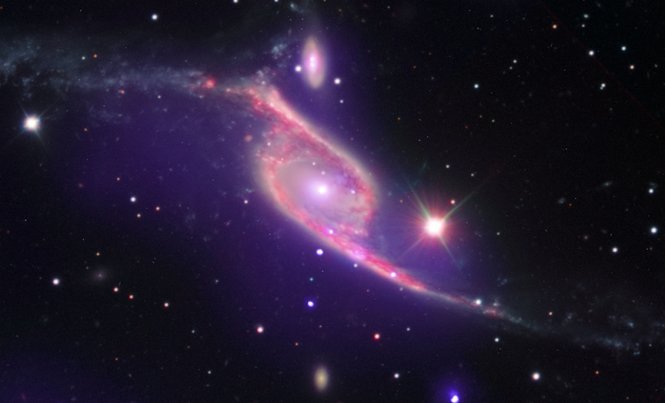There is not enough hot gas in IC 4970 to fuel the growth of the active core. Where does the food supply to the black hole come from? The answer lies in the companion galaxy NGC 6872

This image, composed of data collected by three different telescopes, shows a collision between two galaxies NGC 6872 and IC 4970. X-ray data from NASA's Chandra Space Telescope are shown in purple, while infrared data from the Spitzer Space Telescope are colored red. Optical data from the Very Large Telescope (VLT) of the ESO organization - the European Southern Observatory affiliated to the European Space Agency is seen here in red, green and blue colors.
Astronomers believe that massive black holes reside at the center of most galaxies. Not only do galaxies and black holes seem to co-exist, they are apparently inextricably linked in their evolution. To better understand the symbiotic relationship, scientists turned to rapidly growing black holes in regions known as active galactic nuclei (AGN) - with the aim of learning how they are affected by their galactic environments.
Recent data from the Chandra and Spitzer space telescopes show that IC 4970, the small galaxy at the top of the image, contains an active nucleus (AGN) but is heavily shrouded in clouds of gas and dust. This means that optical telescopes such as the VLT will have a very hard time seeing anything, but X-rays or infrared light can penetrate through the cloak of matter and reveal the light produced when the matter heats up before it falls into the black hole (which appears as a point source of bright light).
Despite the obscuration from the gas and dust surrounding IC 4970, Chandra's data show that there is not enough hot gas in IC 4970 to fuel active core growth. Where does the food supply to the black hole come from? The answer lies in the companion galaxy NGC 6872. The two galaxies are in the middle of a collision process, and IC 4970's gravitational pull has likely pulled some of NGC 6872's cold gas reservoirs (as clearly seen in the Spitzer data) and allowed new fuel to be supplied to fuel the supermassive black hole at the center of IC 4970.

3 תגובות
Thanks
What is the distance between the galaxies?